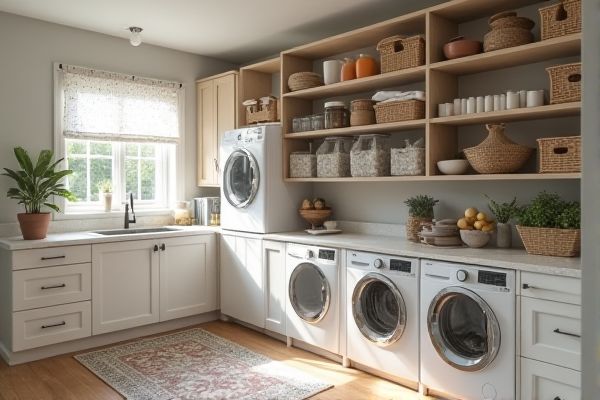
A laundry pantry is designed to store cleaning supplies, detergents, and laundry essentials, while a kitchen pantry primarily holds food items, cookware, and kitchen staples for meal preparation. Discover how choosing the right pantry setup can enhance your home's organization and efficiency by exploring the full article.
Table of Comparison
| Feature | Laundry Pantry | Kitchen Pantry |
|---|---|---|
| Primary Use | Storage for laundry supplies and cleaning products | Storage for food items, spices, and kitchen essentials |
| Common Items Stored | Detergents, fabric softeners, stain removers, cleaning tools | Canned goods, dry foods, snacks, baking ingredients |
| Location | Near laundry machines or utility rooms | Adjacent to kitchen cabinets or within kitchen area |
| Design | Durable shelving with moisture resistance | Adjustable shelves optimized for food storage |
| Temperature & Humidity Control | Moderate ventilation to prevent mold | Cool, dry environment to preserve food quality |
| Size & Space | Compact to medium size for cleaning supply storage | Varies from small cupboards to walk-in spaces |
Introduction to Laundry Pantry vs Kitchen Pantry
Laundry pantries are specialized storage areas designed to organize cleaning supplies, detergents, and laundry essentials, optimizing space and functionality near washing appliances. Kitchen pantries primarily store food items, cooking ingredients, and kitchen tools, enhancing meal preparation efficiency and inventory management. Both pantry types maximize home organization but serve distinct purposes aligned with their respective household tasks.
Key Differences Between Laundry and Kitchen Pantries
Laundry pantries are designed primarily for storing cleaning supplies, detergents, fabric softeners, and laundry tools, whereas kitchen pantries focus on organizing food items, canned goods, spices, and cooking essentials. The shelving in laundry pantries is typically more durable and moisture-resistant to handle detergent spills and humidity, contrasting with the food-safe shelving found in kitchen pantries. Layout differences include laundry pantries often integrating space for washers, dryers, and utility sinks, while kitchen pantries emphasize easy access to food storage and meal preparation items.
Design and Layout Considerations
Laundry pantries prioritize moisture-resistant materials and ample ventilation to prevent mold and maintain fresh airflow, while kitchen pantries focus on maximizing storage space with adjustable shelving and easy accessibility for food items. Your laundry pantry layout often includes dedicated areas for detergents, cleaning supplies, and laundry appliances, whereas kitchen pantries emphasize organized zones for perishables, canned goods, and spices. Efficient design in both spaces enhances functionality but requires tailored solutions to meet their distinct usage demands.
Essential Storage Solutions for Each Pantry
Laundry pantries require specialized storage solutions such as shelves or cabinets designed to hold detergent, fabric softeners, stain removvers, and cleaning tools in an organized manner. Kitchen pantries benefit from adjustable shelving and clear containers that maximize space for dry goods, canned foods, and spices while keeping items visible and accessible. You can optimize each pantry by tailoring storage features to the specific products and usage patterns, enhancing both efficiency and convenience.
Organization Tips for Laundry Pantries
Maximize your laundry pantry space by using stackable bins and labeled containers to keep detergents, fabric softeners, and cleaning supplies neatly organized. Install adjustable shelves to accommodate varying item sizes and add hooks or pegboards for hanging tools like brushes and lint rollers. Incorporate clear storage solutions to easily identify essentials, enhancing efficiency and maintaining a clutter-free laundry area.
Organization Strategies for Kitchen Pantries
Maximizing kitchen pantry organization involves categorizing items by type and frequency of use for easy accessibility. Utilizing clear, labeled containers and adjustable shelving enhances visibility and space efficiency, reducing clutter and food waste. Incorporating pull-out baskets and door-mounted racks further optimizes storage by utilizing vertical and hidden spaces effectively.
Functional Uses: Laundry Pantry vs Kitchen Pantry
Laundry pantries are designed to store detergents, fabric softeners, ironing supplies, and cleaning tools, optimizing space for utility and organization related to garment care. Kitchen pantries serve to organize food items, canned goods, spices, and cooking essentials, emphasizing easy access and preservation of edible products. Both pantry types enhance household efficiency by catering to specific storage needs aligned with their respective functional purposes.
Common Items Stored in Each Pantry Type
Laundry pantries commonly store detergents, fabric softeners, stain removers, dryer sheets, and cleaning supplies like bleach and sponges. Kitchen pantries typically hold non-perishable food items such as canned goods, spices, baking ingredients, snacks, and cooking oils. Both pantry types optimize organization by grouping items based on their specific household function and frequency of use.
Space-Saving Hacks for Both Pantries
Maximize storage efficiency in laundry pantries by utilizing vertical shelving and stackable bins to keep cleaning supplies organized and accessible. In kitchen pantries, incorporate pull-out drawers and adjustable shelves to optimize space for canned goods, spices, and bulk items. Both pantries benefit from door-mounted racks and clear containers to reduce clutter and improve visibility.
Choosing the Right Pantry for Your Home
Selecting between a laundry pantry and a kitchen pantry depends on your home's layout and storage needs. A kitchen pantry is designed to organize food items, cooking essentials, and small appliances, optimizing meal preparation efficiency. In contrast, a laundry pantry stores detergents, cleaning supplies, and laundry accessories, promoting order in utility spaces while freeing up kitchen storage.
 homyna.com
homyna.com